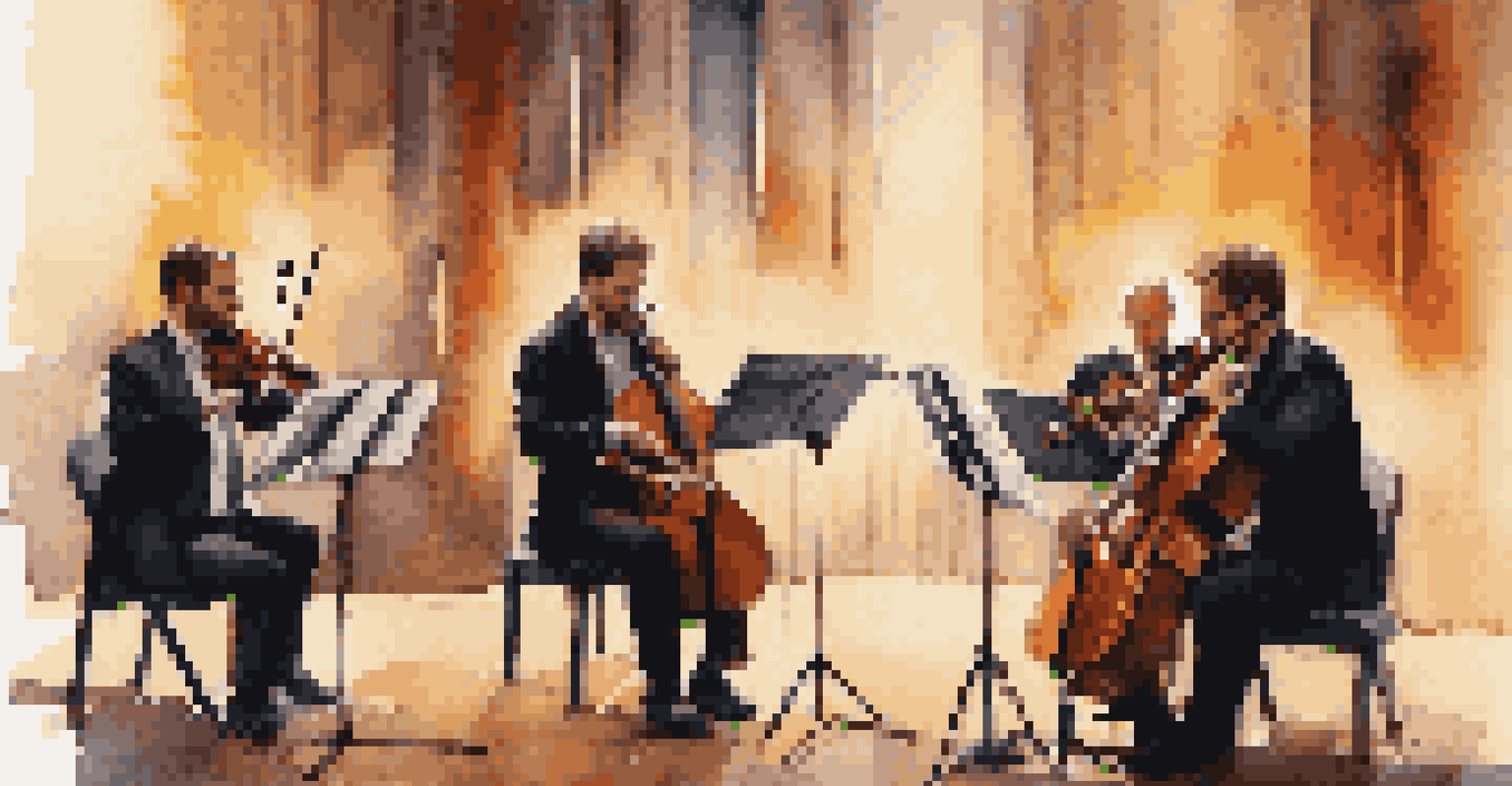Understanding the Role of Dynamics in Music Performance

What Are Dynamics in Music and Why They Matter
Dynamics in music refer to the volume of sound, ranging from soft to loud. This aspect plays a crucial role in conveying emotion and mood within a piece. Just as a painter uses various shades to create depth, musicians use dynamics to add layers to their performances.
Music is the shorthand of emotion.
Understanding dynamics allows performers to connect with their audience on a deeper level. For instance, a gentle piano (soft) can evoke feelings of tenderness, while a sudden fortissimo (loud) can create surprise or excitement. This emotional landscape helps listeners engage more fully with the music.
In essence, dynamics are not just technical markings on a score; they are vital tools for storytelling. Musicians who master the art of dynamics can elevate their performances, making them more memorable and impactful.
The Impact of Dynamics on Musical Interpretation
Musical interpretation is heavily influenced by dynamics, as they dictate how a piece is expressed. Different performers might interpret the same piece uniquely based on their understanding of dynamics. This individuality allows for a rich diversity of performances, even in classical music.

For example, a conductor may choose to emphasize certain dynamic markings to evoke a specific feeling from the orchestra. This decision influences how musicians play their parts, creating a cohesive interpretation that resonates with the audience.
Dynamics Enhance Emotional Expression
Dynamics in music play a crucial role in conveying emotions and mood, allowing musicians to connect more deeply with their audience.
Ultimately, the interplay of dynamics in performance reflects the artist's unique voice. By experimenting with dynamics, musicians can discover new colors and emotional depths within familiar pieces.
Types of Dynamics: Understanding the Spectrum
Dynamics in music are categorized into various levels, ranging from pianissimo (very soft) to fortissimo (very loud). Each dynamic marking serves a purpose, setting the stage for how the music unfolds. Understanding these levels can enhance both performance and listening experiences.
The music is not in the notes, but in the silence between.
For instance, crescendos (gradually getting louder) and decrescendos (gradually getting softer) create tension and release within a piece. This ebb and flow mirrors life's emotional highs and lows, making music relatable and powerful.
By becoming familiar with these dynamic markings, musicians can better interpret the intentions of the composer. This knowledge allows for a more authentic performance, as performers can accurately convey the emotional messages embedded in the music.
Practicing Dynamics: Techniques for Musicians
Practicing dynamics requires intentionality and focus, as it can be easy to overlook in favor of technical proficiency. Musicians can start by isolating passages and experimenting with various dynamic levels. This practice not only strengthens their control but also deepens their understanding of the music.
One effective technique is to play a piece at different dynamic levels, allowing for exploration of how each choice affects the overall feel. Additionally, recording oneself can provide valuable feedback, highlighting areas where dynamics can be enhanced.
Unique Interpretations Through Dynamics
Understanding and manipulating dynamics enables musicians to bring their individual interpretation to a piece, enriching the diversity of performances.
Ultimately, by dedicating time to practice dynamics, musicians cultivate a richer, more expressive performance style. This not only benefits their musicianship but also captivates audiences, drawing them into the musical narrative.
The Role of Dynamics in Ensemble Playing
In ensemble playing, dynamics take on an even more significant role, as musicians must blend their sound with others. Effective communication and listening are key to achieving a balanced dynamic range within the group. This collaboration fosters a sense of unity and shared expression.
For example, a string quartet must carefully navigate dynamics to ensure that each instrument complements the others. If one player is too loud, it can overshadow the entire performance, disrupting the intended emotional impact of the music.
By actively discussing and practicing dynamics as a group, ensembles can create more cohesive performances. This shared understanding leads to a powerful musical experience that resonates with both performers and audiences alike.
Dynamics in Different Musical Genres
Different musical genres approach dynamics in unique ways, shaping the overall sound and feel of the music. In classical music, dynamics are often meticulously notated, whereas in jazz, musicians might rely more on improvisation and personal expression. Each genre offers its own dynamic challenges and opportunities.
For instance, in rock music, dynamics can be used to create dramatic contrasts between verses and choruses, enhancing the emotional impact of the song. The use of dynamics in pop music often aims for catchiness, where subtle changes can make a significant difference in how a song resonates.
Dynamics Vary Across Musical Genres
Different musical genres utilize dynamics in unique ways, influencing the overall sound and emotional impact of the music.
By exploring dynamics across genres, musicians can expand their toolkit and develop a versatile playing style. This knowledge allows them to adapt their performances, connecting with diverse audiences and enriching their musical journey.
Conclusion: Embracing Dynamics in Music Performance
In conclusion, dynamics are an essential component of music performance, influencing interpretation, emotional expression, and audience engagement. By understanding and mastering dynamics, musicians can transform their playing, making it more expressive and impactful. This journey not only enhances their artistry but also fosters a deeper connection with their audience.
As musicians, embracing dynamics opens up a world of possibilities, allowing for creativity and individuality in every performance. Whether in solo or ensemble settings, dynamics serve as the heartbeat of music, guiding the emotional narrative.

Ultimately, the art of dynamics invites both performers and listeners to experience music in a profound way. By appreciating and practicing this vital element, musicians can leave a lasting impression on their audience and elevate their craft.